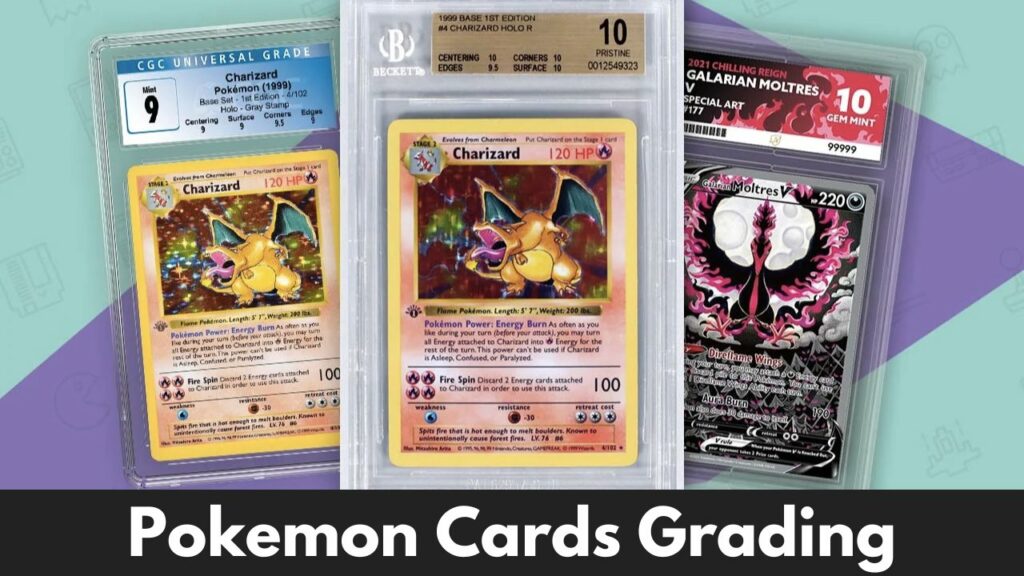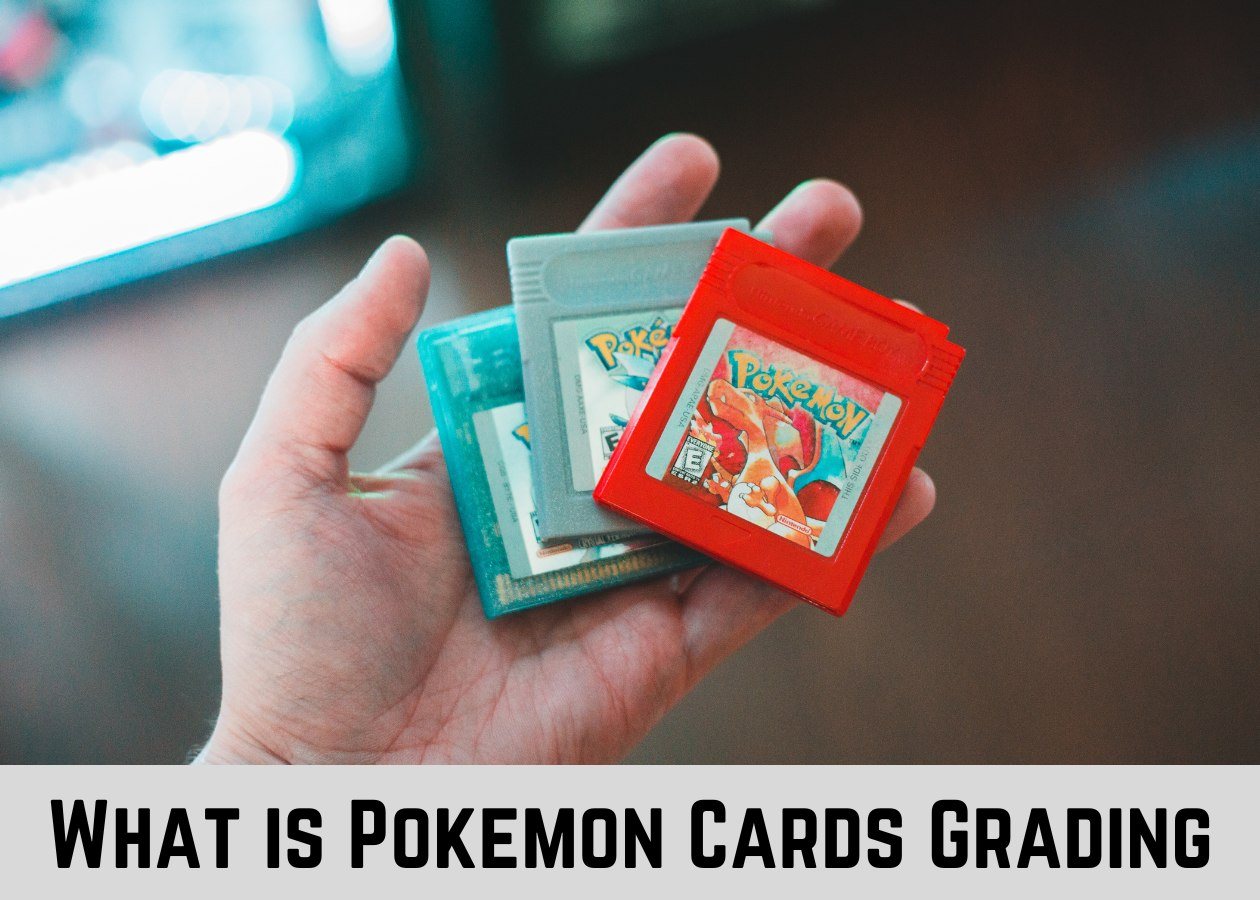Are you curious about what is pokemon cards grading? Do you want to know what makes a card condition “mint”?
This article will explain the basics of grading pokemon cards to understand what to look for when we want to grade pokemon cards. Whether you are a collector or a trader, it is important to know card grades and their values. Let’s get started!
What are Pokemon Cards Grading
Pokemon card grading is the process of getting the condition of your Pokemon cards evaluated by a professional. Cards graders are professional card appraisal companies. They use a card grading system to determine the condition and worth of cards.
The most common card grading system is the 10-point card grading scale. The Pokemon cards grading scale usually goes from 1 to 10, with 10 being mint condition and 1 being unplayable.

Different Card Grading Conditions
Card grading companies created this card grading scale. Out of these 10, 8- The most important point grading conditions are as follows:
- The card is in Mint Condition
- The card is Near Mint – Mint Condition
- The card is Excellent – Mint Condition
- The card is Very Good – In excellent condition
- The card is Good – Very Good Condition
- The card is in Fair – Good Condition
- The card is in Poor – Fair Condition
- Bled Through on Back or Front
Most people collect cards for fun and don’t need them to be professionally graded, but there are some occasions when necessary.
For example, if you’re looking to sell your cards, you’ll need to appraise them to know their worth. And if you’re looking to buy cards at auction, you’ll want to be sure that the cards you’re bidding on are in the condition they’re described as being in.
What is Mint Condition?
Mint condition is the highest grade a card can receive. A mint condition card will look like it came off the printing press. It will be free of any scratches, scuffs, or stains.
The corners will be sharp, and the colors will be bright and vibrant. Mint condition cards are very rare and typically command high prices.

What is Near Mint – Mint Condition?
Near mint-mint condition is the second-highest grade a card can receive. A near-mint-mint condition card will look like it was just printed, but it may have a small flaw. A slight ding in the corner is the most common flaw on a near-mint-mint condition card.
Near mint -mint condition cards are less common than mint condition cards, but they still command high prices.
What is Excellent-Mint Condition?
Excellent-mint condition is the third highest grade a card can receive. An excellent-mint condition card will look like it was just printed, but it will have two or more small flaws.
The most common flaws on an excellent-mint condition card are dings in the corners and scratches on the surface. Excellent-mint condition cards are less common than near-mint-mint condition cards, but they can still command high prices.
What is Very Good – Excellent Condition?
Very Good to Excellent condition is a Pokemon card with very little wear, with only minor imperfections such as slight scuffing or scratching.
A card in Very Good-Excellent condition will look nearly indistinguishable from a brand-new card and command a high price from collectors.
What is Good Condition?
Good condition means that the card is still in playable condition. The card should be free of any major wear and tear, such as creases, folds, or bends.
The edges of the card should also be in good condition, with no nicks or fraying. The card’s surface should be clean, with little to no dirt or staining.
What is Fair Condition?
The fair condition means that the card is still playable but may have some wear and tear. This can include minor creases, folds, or bends.
The edges of the card may also be slightly damaged, with minor nicks or fraying. The surface of the card may also be somewhat dirty or stained.
What is Poor Condition?
The poor condition means the card is heavily worn and unsuitable for competitive play. This can include cards that have significant creasing, folding, or bending.
The edges of the card may also be heavily damaged, with nicks, fraying, or missing pieces. The surface of the card may also be very dirty or stained.
Bled Through on Back or Front
Folded to the point where the back or front bleeds through to the other side. This is often caused by a heavy object placed on top of the card, causing it to warp and crack.

Why do You need to Grade Your Pokemon Cards?
There are a few qualifying reasons why you might want to get your Pokemon cards graded. The first reason is if you’re looking to sell your cards. Professional grading can give you a better idea of how much your cards are worth and make them more appealing to potential buyers. Grading can also be important if you’re looking to insure your collection. Insurance companies will often require that collections be professionally graded to provide coverage. Finally, grading can simply be a way to preserve the condition of your cards and keep them looking their best.
How to Grade Pokemon Cards
If you’re considering getting your cards graded, it’schoosing a reputable card grader is important.
Many companies will gladly take your money but give you an inaccurate grade. So be sure to complete your research before entrusting your cards to anyone!
If you’re a big fan of Pokemon cards, you know that some cards are more valuable than others. But how do you determine the value of a card? That’s where card graders come in.

Card graders are experts at assessing the condition of cards and assigning them a numerical grade on a scale of 1 to 10, with 10 being the highest.
What Affects The Worth Grading Of Pokemon Cards
Cards graders are assigned a card’s rarity based on some factors. The first and most important factor is the card’s print run. The card print run is the number of cards printed by the manufacturer.
The second factor is the card demand. The card demand is determined by the number of people who want to own the cards. The third and final factor is the card supply.
The card supply is determined by the number of people who already own the cards.
The most general & common question I am asked is, what affects the grading of pokemon cards? While many variables can contribute to a card’s grade, I would say that three factors have the greatest impact on a card’s value: print run, demand, and supply.
The print run of a card is important because it tells us how many copies of the card were made. Cards with a low print run will typically be more valuable than those with a high print run because fewer copies exist. This means less competition for the scarce cards, which drives up prices.

The demand for a card also plays a role in its value. If many want to own a particular card, it will be more valuable than one not in high demand. More people are competing for the same card, which drives up prices.
The supply of a card is also important in determining its value. If few people own a particular card, it will be more valuable than one in high supply. This is because there are fewer cards available, which drives up prices.
How To Get Your Pokemon Card Graded
If you’re a Pokemon Trading Card Game fan, you may be interested in having your cards professionally graded. Graded cards are assessed for condition and assigned a numerical grade on a scale from 1 to 10, with the number 10 being the highest. While several companies offer card grading services, some are more reputable than others. So be sure to complete your research before entrusting your cards to anyone!
Conclusion:
That’s it! We’ve covered all you need to know about grading Pokemon cards. Now that you understand the conditions, how to grade them, and what affects their worth, it’s time for you to put this knowledge into practice. If you have any important questions or want advice on where to start, let us know in the comments below – we’re always happy to help. And finally, don’t forget to share this article with your friends so they can benefit from our guide too!
FAQs
Is it worth getting Pokemon cards graded?
Yes, it can be worth getting your Pokemon cards graded because it can increase the value of your collection. The most important factor in determining a card’s value is its condition, so having a professional grade assigned to your cards can give you a better idea. However, it’s important to remember that grading fees can add up, so you’ll need to weigh the cost of grading against the potential increase in value.
How does Pokemon grading work?
Pokemon grading is a process by which cards are assessed for condition and assigned a numerical grade on a scale of 1 to 10, with 10 being the highest. Cards in mint condition will typically receive a grade of 9 or 10, while heavily damaged cards may receive a grade as low as 1.
How much does it cost to grade a Pokemon card?
Fees for grading services vary depending on the company you use and the number of cards you’re submitting. For example, PSA (Professional Sports Authenticator) charges $10 per card for standard grading, while CGC (Certified Guaranty Company) charges $5 per card. Shipping and handling fees will also apply.
